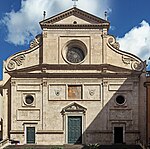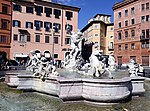Pontifical University of the Holy Cross

Pontifical University of the Holy Cross (Latin: Pontificia Universitas Sanctae Crucis, Italian: Pontificia Università della Santa Croce) is a Roman Catholic university under the Curial Congregation for Catholic Education, now entrusted to the Prelature of the Holy Cross and Opus Dei, or more commonly called Opus Dei. It was started in 1984 by Opus Dei, with the aim of offering the universal church an effective instrument for formation and research. Located in the heart of Rome, it has two campuses. One is in Piazza di Sant'Apollinare, northern area of Piazza Navona; another (the library) is Via dei Farnesi near the famous Palazzo Farnese. Its stated mission is "to serve the whole Church by means of a broad and thorough work of research and formation in the ecclesiastical sciences, cooperating according to its special function with the evangelizing mission of the Church in the whole world." Pope John Paul II granted the title of 'university' to the Pontifical Atheneum of the Holy Cross in July 1998, making it the sixth pontifical university in the city of Rome. The University is open to lay people, both men and women, priests, seminarians, and religious brothers and sisters.
Excerpt from the Wikipedia article Pontifical University of the Holy Cross (License: CC BY-SA 3.0, Authors, Images).Pontifical University of the Holy Cross
Piazza di Sant'Apollinare, Rome Municipio Roma I
Geographical coordinates (GPS) Address Nearby Places Show on map
Geographical coordinates (GPS)
| Latitude | Longitude |
|---|---|
| N 41.900833333333 ° | E 12.473611111111 ° |
Address
Piazza di Sant'Apollinare 49
00186 Rome, Municipio Roma I
Lazio, Italy
Open on Google Maps










